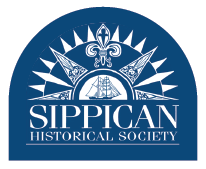
From the Archives
~ contributed by Abigail Field
Competitive yachting has been a robust part of Marion’s history since the founding of the Beverly Yacht Club and the Sippican Yacht Club in the 1870s. Many notable figures in American history were involved, including President Grover Cleveland and his wife, Frances, as well as Nathanael Herreshoff. But what of the yachts that were meant purely for leisure, rather than winning races? It is from one of these very boats that we received a large collection of Johnson Brothers china.
The custom English porcelain is quite fine, as is the decoration itself. All the pieces in the set have gilded edges along a cobalt blue rim, and most have carefully painted additional decoration depicting the burgees of the Beverly Yacht Club and of James E. Whitin, the original owner of the china and the boat from which it came. The set includes large platters, soup cups, tea cups, saucers, dessert plates, soup bowls, and luncheon and dinner plates. The set is no longer complete; nevertheless, it suggests the grandeur of luxurious meals served aboard the yacht. One wonders how the interior of the vessel was decorated, who was employed aboard, and who were the guests invited to dine in such splendor.
In 1927, James E. Whitin, president of the Uxbridge Cotton Mill, and founder of Whitinsville (a village within Northbridge, in Worcester County), commissioned the building of the seagoing diesel yacht which he named Coronia. The yacht was designed and built by John H. Wells Inc., of Defoe Boat Works in Bay City, Michigan. The boat’s home port was Marion, MA, so, given that Whitin lived in North Uxbridge, it appears that Mr. Whitin was one of the many distinguished summer residents of Marion. This fact is further supported by the china set, which features the burgees of both Mr. Whitin and the Beverly Yacht Club!
Unlike the china, Coronia did not enjoy a long life. At the onset of World War II, the boat was commandeered by the United States Navy, renamed Androdite, and set to patrol the coast off of California. After the war ended, the yacht was transferred to the Maritime Commission for disposal, but was instead transferred yet again to the War Shipping Administration. Here it was renamed Coronia and would serve with the coast and geodetic service. By 1952, the boat was sold to the North Coast Timber Corporation of San Francisco.
Although originally a luxury yacht, Coronia spent over half its life as a utilitarian vessel, finally being destroyed by burning in 1956 off of Canton Island in the Pacific Ocean. The Sippican Historical Society is grateful for the opportunity to preserve, and one day display, the surviving English china that helps illustrate Coronia’s interesting history.

